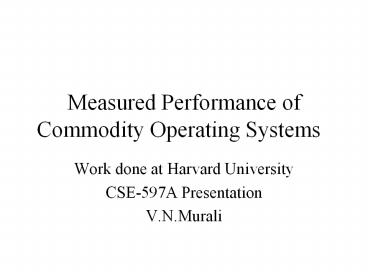Measured Performance of Commodity Operating Systems - PowerPoint PPT Presentation
Title:
Measured Performance of Commodity Operating Systems
Description:
Measured Performance of Commodity Operating Systems Work done at Harvard University CSE-597A Presentation V.N.Murali – PowerPoint PPT presentation
Number of Views:37
Avg rating:3.0/5.0
Title: Measured Performance of Commodity Operating Systems
1
Measured Performance of Commodity Operating
Systems
- Work done at Harvard University
- CSE-597A Presentation
- V.N.Murali
2
Initial Remarks
- Any ideas?
- Windows for WorkgroupsMost expensive due to
frequent changes in machine mode and system call
hooks. - NTmore efficient than above,overhead due to
microkernel-like design(Win-32 API is a
user-level server) - NetBSDMost efficient
3
Components
WINDOWS Segmented memory,Virtual Machine Monitor,Windowing System,Graphics engine WINDOWS NT Executive(IPC,VM,IPC,File system,N/W) Win32 Subsystem(Windowing System) NET BSD Monolithic kernel,X11 Windowing System
4
Device Drivers
- WindowsVxD(virtual Device Drivers) which are
activated by hardware interrupts,system calls
and/or entry points. - NetBSD/dev file is installed.Load a driver and
access the counter using the device
file.Configured using ioctl() - NTDDk is the API for driver development.Loaded
into the NT executive
5
Microbenchmarks
- Null counter access latency.
- Syscall minimum system call latency
- Exec latency to load and run a program
- Memory access time access times for arrays
(various sizes) - File System
- BitBlt Graphics subsystems
- Network
6
Application workloads
- Wish command interpreter for the Tcl language
(test for GUI subsystem,CPU intensive,very little
Disk activity) - Ghostscript
- WWW server
- (ASSUMPTIONSSingle user mode,little or no
background activity)
7
Metrics
- Cycle counts.
- Instruction counts ? ( Would this be a correct
metric ?) - Data read/write references ??(Similar arguments)
- Cache and TLB misses (Icache,Dcache,ITLB,DTLB)
8
RESULTSNull micro
- Least instruction count Windows. Why?
- Maximum instruction count Windows NT.Why?
- Higher CPI Windows.Why?
- Highest cycle counts NT.Why?
- Highest instruction cache miss NT.Why?
9
RESULTSSyscall micro
- Used a simple system call(dup) on UNIX and
NT.Get_extended_error_info (16bitWin,int21),get_in
terrupt_vector (32bit,int 21).. - Overhead for dup in NT and BSD is same as Null
benchmark.Similar behavior in I-cache misses for
NT. - Most efficient in terms of cycle counts? Windows
32 bit system call?
10
Contd.
- Windows 16 bit is very expensive?Why?
- Hooks?System calls can be intercepted in DOS.Used
for CDROM drivers,caching etc - Most EfficientNetBSD and Windows 32 bit.Both NT
and Windows 16 are expensive.
11
RESULTSExec micro
- NetBSD uses a vfork() and exec() combo while NT
uses CreateProcess().Windows has a shared address
space,so nothing is created. - Most efficient NetBSD static.Why?
- Worst NT dynamic.Why?
12
Contd..
- Windows overhead is higher than NetBSD static and
lower than either OSs dynamic linkage - Maximum data reads and writes NT.Why?
- Dynamic linkage incurs a lot of overhead.
13
RESULTSMemory Access time
- Repeated references to arrays of various sizes
using stride128bytes. - 8k on chip cache and 256K onboard cache.
- NT uses a deterministic page mapping policy gt
similar performance upto 256K and smooth
degradation afterwards - NetBSD uses a non-determinstic page mapping
policy.Hence poor performance for gt8k size
14
Contd.
- NTs file system buffer cache is integrated to
the VM system.This rings a bell doesnt it?? - 64k segment size in Windows limits performance
15
RESULTSFile System Micro
- 3 activities,a)Hit in disk cache b)Access to
small files c)Creation - Tested NTFS and FAT32 for Windows NT,FAT 16,32
for Windows,FFS for NetBSD. - Least overhead NetBSD
- Most overhead NT/NTFS,FAT 16.
16
Contd..
- Meta data updates NTFS performs the best because
it logs them,while FFS performs poorly because of
synchronous writes.
17
RESULTSGraphics micro
- Display an array of pixels repeatedly
- Worst performance . NetBSD.Why?
- NETWORK THROUGHPUT
- Worse code locality for NT gt instruction cache
and TLB misses. - However throughput is comparable to
BSD.Limitation is due to the ethernet.
18
Summary
- Frequent CPU mode changes in Windows expensive
- 64K segment size is a limitation
- Higher instruction counts and cache misses for NT
?Why? - Efficient graphics and relaxed file system
semantics in NT
19
Application workloads
- WishOverhead includes context switches and
IPC.Highest overhead in Windows.Why? - NT is worse than BSD.Why?
- Ghostscript Best performance by NT and Windows
- Web ServerBest results for NetBSD and
Windows,Worst results for NT.NT is believed to
have a very poor network implementation.

